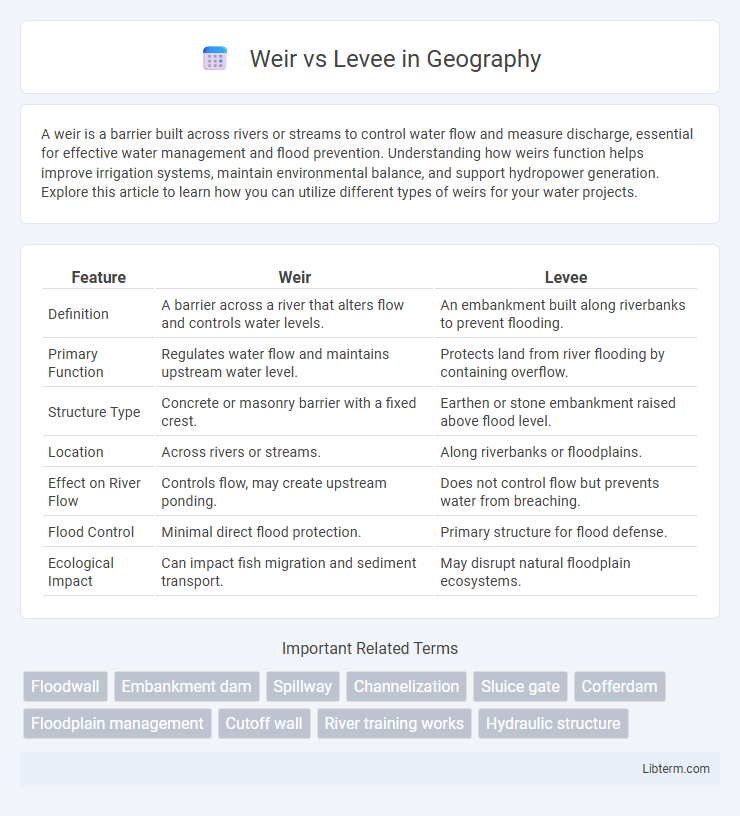A weir is a barrier built across rivers or streams to control water flow and measure discharge, essential for effective water management and flood prevention. Understanding how weirs function helps improve irrigation systems, maintain environmental balance, and support hydropower generation. Explore this article to learn how you can utilize different types of weirs for your water projects.
Table of Comparison
| Feature | Weir | Levee |
|---|---|---|
| Definition | A barrier across a river that alters flow and controls water levels. | An embankment built along riverbanks to prevent flooding. |
| Primary Function | Regulates water flow and maintains upstream water level. | Protects land from river flooding by containing overflow. |
| Structure Type | Concrete or masonry barrier with a fixed crest. | Earthen or stone embankment raised above flood level. |
| Location | Across rivers or streams. | Along riverbanks or floodplains. |
| Effect on River Flow | Controls flow, may create upstream ponding. | Does not control flow but prevents water from breaching. |
| Flood Control | Minimal direct flood protection. | Primary structure for flood defense. |
| Ecological Impact | Can impact fish migration and sediment transport. | May disrupt natural floodplain ecosystems. |
Introduction to Weirs and Levees
Weirs are hydraulic structures built across open channels to measure flow rates or regulate water levels by allowing water to flow over a crest. Levees are embankments constructed alongside rivers or shorelines to prevent flooding by containing or diverting water. Both weirs and levees play crucial roles in flood management and water resource control within hydraulic engineering.
Definition of Weir
A weir is a small barrier built across a river or stream to regulate water flow, measure discharge, or raise the water level upstream. Unlike levees, which are embankments constructed alongside rivers to prevent flooding, weirs directly influence water levels and flow rates by allowing excess water to spill over their crest. Commonly made from concrete, wood, or stone, weirs serve essential roles in irrigation management, hydrological measurements, and ecosystem control.
Definition of Levee
A levee is a natural or artificial embankment constructed along rivers or coastlines to prevent flooding by containing or redirecting water flow. Unlike a weir, which is a structure built across a river to regulate water flow or measure discharge, levees primarily serve as protective barriers against high water levels. Effective levee design involves materials such as earth, concrete, or rock to ensure durability and resistance against erosion during flood events.
Key Differences Between Weir and Levee
A weir is a structure built across rivers or streams to control water flow and measure discharge, typically featuring a notch or overflow crest. In contrast, a levee is an embankment constructed alongside rivers or large water bodies designed primarily to prevent flooding by containing rising water levels. While weirs regulate and monitor water flow, levees serve as protective barriers against floodwaters, highlighting their distinct functional purposes in water management.
Functions and Purposes
Weirs regulate and measure water flow in rivers and canals by allowing excess water to spill over a fixed crest, ensuring controlled flow rates and water level management. Levees serve as embankments constructed alongside water bodies to prevent flooding by containing rising waters within designated channels. Both structures play crucial roles in water management, with weirs primarily controlling flow and measuring discharge, while levees provide flood protection and land preservation.
Common Materials Used
Common materials used for weirs include concrete, steel, and timber, chosen for their durability and ability to withstand high water flow and pressure. Levees are typically constructed using earth materials such as compacted soil, clay, sand, and sometimes reinforced with rock or geotextiles to enhance stability and erosion resistance. Both structures require materials that provide structural integrity and resist hydraulic forces to effectively manage water flow and prevent flooding.
Design and Construction Techniques
Weirs are designed as overflow structures with a fixed crest that regulates water flow and maintains upstream water levels, typically constructed from concrete or masonry for durability and precision. Levees are embankments built parallel to riverbanks or shorelines using compacted earth, rock, or synthetic materials to provide flood protection by containing or diverting water. Construction of weirs requires precise engineering for crest height and spillway shape to control discharge, whereas levee construction focuses on slope stability, erosion control, and foundation strengthening to resist hydraulic pressure and seepage.
Applications and Use Cases
Weirs are commonly used in streamflow measurement, water level control in irrigation channels, and small-scale hydroelectric projects because their simple design allows precise flow regulation and monitoring. Levees serve primarily as flood protection structures, preventing water from overflowing riverbanks and safeguarding urban areas, agricultural land, and critical infrastructure from flood damage. Both weirs and levees play crucial roles in water resource management but are chosen based on specific application needs like flow measurement versus flood defense.
Advantages and Limitations
Weirs offer precise flow measurement and control with relatively simple construction, making them suitable for low-height water control and sediment management; however, they can cause upstream flooding and are less effective for large-scale water retention compared to levees. Levees provide robust flood protection by elevating land boundaries and preventing river overflow, which is essential for safeguarding extensive urban and agricultural areas but require significant maintenance and can fail catastrophically if overtopped or breached. Both structures play crucial roles in water management, where the choice depends on site-specific needs such as flow regulation accuracy versus large-area flood defense.
Conclusion: Choosing Between Weir and Levee
Selecting between a weir and a levee depends on the specific hydraulic and environmental requirements of the site. Weirs efficiently regulate water flow and measure discharge in rivers and canals, offering precise control in controlled water systems. Levees provide critical flood protection by acting as barriers that prevent overflow, making them essential for safeguarding large populated areas from flooding risks.
Weir Infographic

 libterm.com
libterm.com